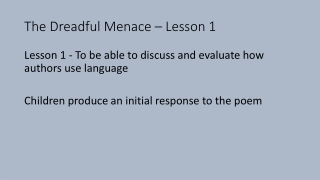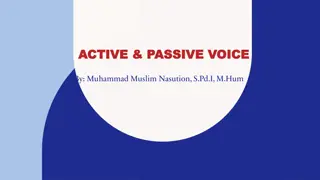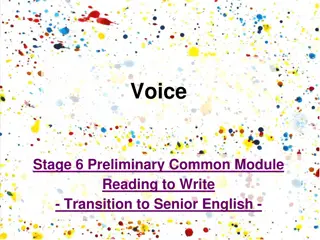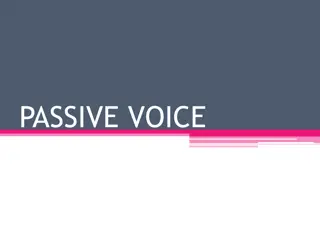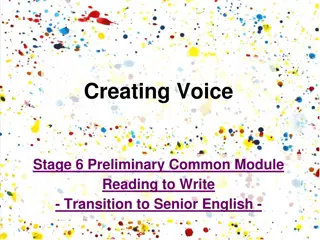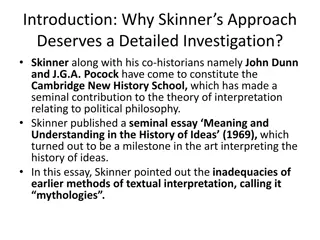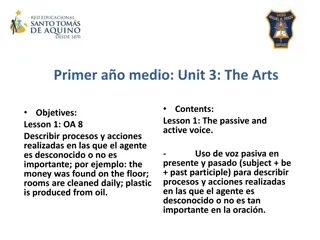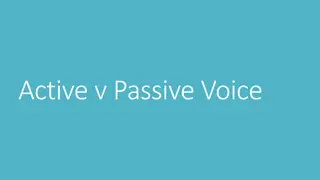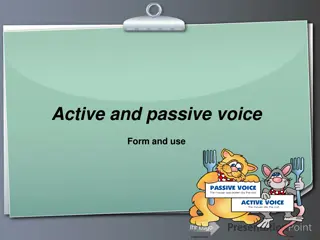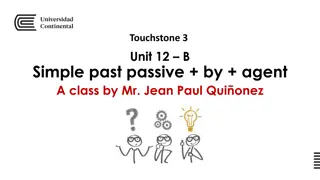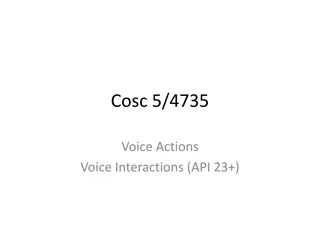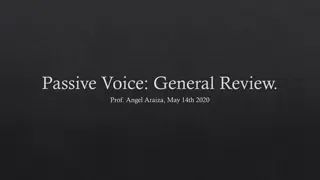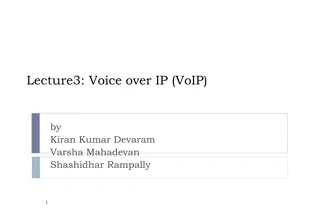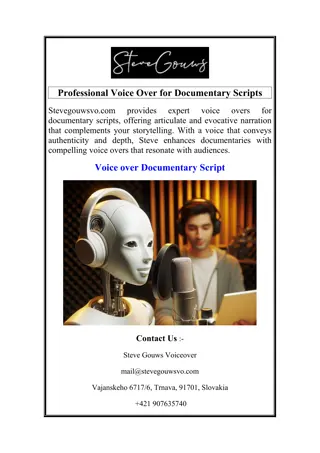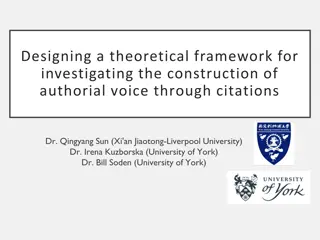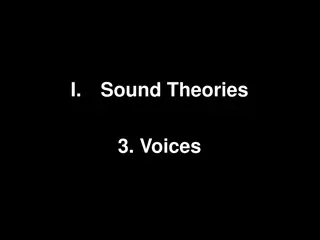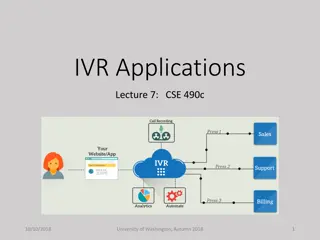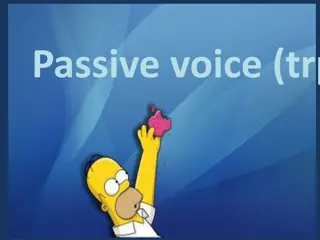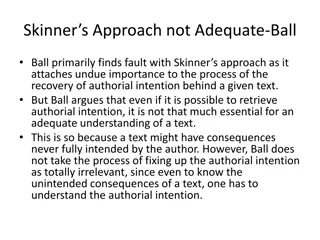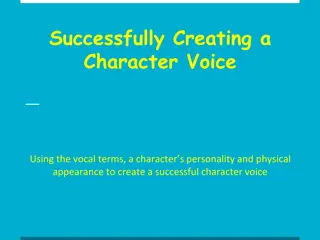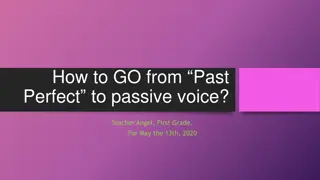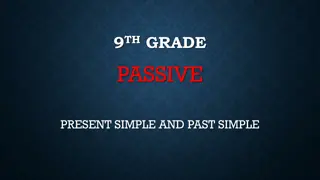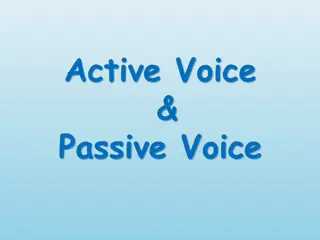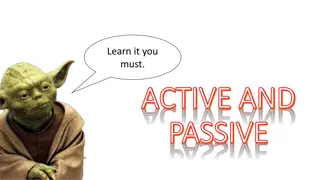Exploring Language in "The Dreadful Menace" Lessons
Delve into how authors use language in the poem "The Dreadful Menace" through activities such as producing initial responses, analyzing word choices, and discussing personification. Students engage with the text through discussions, definitions of key words, and examples of authorial intent, fosteri
0 views • 17 slides
Is regressive voice assimilation a mirage?
Delve into the discussion on regressive voice assimilation, challenging traditional views of laryngeal phonology. Explore the intricate phonetic cues and contrasts that go beyond Voice Onset Time (VOT), examining the complexities of active [-voice] in voicing languages. Discover the prevalence of re
2 views • 28 slides
Understanding Active and Passive Voice Usage
Learn about the differences between active and passive voice in English grammar, how to convert sentences from active to passive voice, and examples of active and passive voice usage in different tenses. Understand which verbs can be used in passive voice constructions and practice changing sentence
9 views • 7 slides
Enhancing Writing Skills at Pucklechurch C of E Primary School
At Pucklechurch C of E Primary School, a strong focus is placed on teaching writing fundamentals and fostering an authorial voice across the curriculum. The school shares its successes, writing foci, and strategies for nurturing successful writers, including the use of high-quality texts, exposure t
0 views • 15 slides
Text Type Focus: Interviews
Interviews in English Language and Literature aim to entertain readers, fulfill their curiosity, and provide new insights on various topics. They typically follow a question-answer format and may present a mix of reported and direct speech. Interviews can cover a single topic or multiple subjects, w
1 views • 10 slides
Understanding the Concept of Voice in Literature
Voice in literature refers to the unique personality imparted by an author onto their work, defining how narrators convey stories. This piece explores the definition, types, functions, and roles of voice in literary works, focusing on the author's voice, character's voice, and the interaction betwee
2 views • 11 slides
Understanding Passive Voice in English Grammar
Explore the concept of passive voice in English grammar through examples and explanations. Learn how to identify passive voice, transform active voice sentences into passive voice, and understand the importance of focusing on the action rather than the doer. Discover the structure of passive voice s
2 views • 7 slides
Understanding Active and Passive Voice in Writing
Active Voice is when the subject performs the action, while Passive Voice is when the subject receives the action. Writers often choose Active Voice for clarity, but Passive Voice is useful when emphasizing the receiver or if the doer is unknown. Avoid mixing voice types to maintain consistency in w
1 views • 6 slides
Understanding Passive Voice and Verb Forms in English
Explore the concept of passive voice in English grammar through examples and explanations of modal verbs, infinitives, gerunds, and verb forms. Learn how to form passive sentences and identify different verb structures. Practice converting active voice sentences to passive voice for a deeper underst
1 views • 9 slides
Discovering Literary Techniques for Creating Voice in Writing
Explore various literary techniques such as nouns, adjectives, adverbs, verbs, pronouns, dialogue, repetition, punctuation, imagery, irony, and setting to enhance voice in writing. Delve into how these elements shape characters, set moods, and convey meanings, offering insight into crafting compelli
0 views • 8 slides
Revisiting Skinner's Approach to Political Philosophy Interpretation
Skinner's approach, as part of the Cambridge New History School, challenges traditional methods of interpreting political philosophy texts. He critiques existing approaches for overlooking authorial intention and leading to flawed conclusions. By advocating for a historically sensitive reading, Skin
0 views • 14 slides
Understanding Passive and Active Voice in English Language
Learn about the passive and active voice in English grammar, focusing on describing processes and actions where the doer is unknown or unimportant. Explore examples, differences between active and passive voice, and how to convert sentences from active to passive voice. Practice activities to enhanc
1 views • 12 slides
Understanding Active vs Passive Voice in Writing
Active vs passive voice explained with examples, definition, and two ways to fix passive voice. Learn how to change passive voice sentences to active voice with practical examples provided.
8 views • 5 slides
Understanding the Passive Voice and Versatile Verbs
Explore the concept of the passive voice and versatile verbs, including examples and reasons for using passive voice constructions. Learn about verb tenses, when to use passive voice for cohesion or when the agent is unknown, and how to add modifiers to the agent. Discover tips for using passive voi
0 views • 15 slides
Mastering Passive Voice: Verb Forms and Usage
Delve into the intricacies of passive voice in English grammar, exploring verb forms commonly used in the passive voice such as manufacturing, publishing, and more. Learn how to construct passive sentences in Present Simple and Past Simple tenses with examples and practice exercises. Enhance your un
0 views • 6 slides
Understanding Active and Passive Voice in English Writing
Explore the forms and uses of active and passive voice in English writing with examples and explanations. Learn how to distinguish between active and passive voice, create passive sentences using appropriate tenses, and understand when to use each voice effectively in different situations. Enhance y
0 views • 15 slides
Understanding Passive Voice in English: Usage and Examples
Passive voice is used to shift the focus from the subject to the object in a sentence. The passive construction is formed with the verb "to be" in the appropriate tense followed by the past participle of the main verb. Learn when to use passive voice, how to indicate the agent using "by," and how ad
0 views • 6 slides
Voice Actions with Google App: Integration Guide
Learn how to integrate voice actions using the Google App for API 23+ in your Android app. This guide covers setting up intent filters, receiving actions in activities, and completing actions with the Google API. Explore the capabilities of voice interactions and enhance user experience with voice c
0 views • 18 slides
Understanding Passive Voice and Verbal Times
Passive voice focuses on the object of the sentence, with examples of converting sentences from active to passive voice in different verbal tenses. It explains the concept of subject giving an object in active voice and the reception of the object in passive voice. The importance of subject in a sen
0 views • 9 slides
Understanding Passive Voice: Rules and Examples
Passive voice is a grammatical construction used when the focus is on the action itself rather than the doer. It is formed by combining a form of "to be" with the past participle of a verb. This content explores the usage of passive voice in different tenses - present simple, present continuous, pas
0 views • 14 slides
Understanding Passive Voice in English Grammar
This content covers the concept of passive voice in English grammar, providing examples and explanations of how to form passive voice sentences. It includes information on intransitive and transitive verbs, transforming active voice to passive voice, and common passive voice structures. Visual aids
0 views • 16 slides
Understanding Voice over IP (VoIP) Technology
Explore the world of Voice over IP technology through this comprehensive lecture covering VoIP basics, motivations, implementation methods, configuration options, main issues, standards, and ISO reference model. Learn about VoIP's ability to make calls over IP networks, motivations behind its use, t
0 views • 37 slides
Professional Voice Over for Documentary Scripts
Stevegouwsvo.com provides expert voice overs for documentary scripts, offering articulate and evocative narration that complements your storytelling. With a voice that conveys authenticity and depth, Steve enhances documentaries with compelling voice
3 views • 1 slides
Understanding Authorial Voice Construction Through Citations
Investigate the significance of authorial voice in academic writing and the challenge students face in understanding and incorporating it. Delve into the concept, construction, and implications of authorial voice, exploring its connection with citations and stance. Examine individual and social voic
0 views • 25 slides
Exploring Theories and Concepts of Voice and Self-Expression
Delve into the realm of voice, self-expression, and consciousness through various theories and perspectives by thinkers such as Derrida and Barthes. The concept of voice is examined in relation to presence, uniqueness, power, and language, highlighting its subjective and spiritual dimensions. Explor
0 views • 34 slides
Voice-Induced Vowel Lengthening in Phonology Research
Exploring the phenomenon of voice-induced vowel lengthening, this research delves into spontaneous vs. non-spontaneous voicing patterns and the documented transmission of voicing from vowels/sonorants to voiceless obstruents. The study discusses various theories on voice transmission from sonorants/
2 views • 35 slides
Mastering Active and Passive Voice in English: A Comprehensive Guide
Explore the fundamental concepts of active and passive voice in English through this detailed guide. Learn how to identify and transform sentences from active voice to passive voice, understand the usage of auxiliary verbs, and practice changing sentence structures effectively. Enhance your language
0 views • 19 slides
Understanding D-STAR: A Comprehensive Guide to Digital Voice and Data for Amateur Radio
D-STAR is an open standard for digital voice and data in Amateur Radio, developed by the Japan Amateur Radio League (JARL). It uses the AMBE vocoder chip to convert analog speech to data and vice versa, leading the way in encouraging experimentation and open development. The technology ensures high-
0 views • 19 slides
Learn Grammar: Active and Passive Voice Conversion Exercises for Class Eight English
This lesson focuses on changing active voice sentences into passive voice, covering various examples with explanations. Through visual aids and practical exercises, students will grasp the concept and apply it effectively. The content includes converting sentences, identifying passive voice structur
1 views • 17 slides
Interactive Voice Response Applications in University Environment
Explore the world of Interactive Voice Response (IVR) applications in an educational setting through examples like SMS communication, voice applications, advantages of voice and text, technology core features, and social good initiatives. Discover how IVR technology is used for educational purposes
0 views • 14 slides
Understanding Active and Passive Voice in English Grammar
Learn about active and passive voice in English grammar with examples and practice exercises. Understand the difference between active and passive voice, how to form sentences in both voices, and practice converting sentences from active to passive voice. Improve your language skills with this compr
1 views • 19 slides
Exploration of Authorial Intention and Text Reception by Terence Ball
Terence Ball critiques Skinner's emphasis on authorial intention recovery, highlighting how understanding unintended consequences of texts is crucial. He delves into the significance of reader interpretation, proposing a theory of three-cornered fight to navigate diverse perspectives in text analysi
0 views • 11 slides
Mastering Character Voice Creation
Explore the art of creating a character voice by understanding vocal terms, personality traits, and physical appearance. Learn how pitch, quality, rate, emphasis, inflection, and articulation shape a character's voice. Dive into developing character personality, traits, and sharing insights for effe
0 views • 13 slides
Transforming Sentences from Past Perfect to Passive Voice
Learn how to convert sentences from the Past Perfect tense to Passive Voice with clear examples and a step-by-step guide. Understand the formula and rules for changing active voice sentences to passive voice sentences in English grammar. Explore how singular and plural subjects affect the transforma
0 views • 9 slides
Understanding Passive Voice in English Grammar
Passive voice in English occurs when the subject receives the action of the verb. This involves changing the order of subject and object, using the auxiliary verb "to be" in the tense of the active voice, and adding the past participle of the main verb. Various tenses can be used in passive voice co
1 views • 5 slides
Exploring the Power of Your Voice: Darfur in Sudan
Unleash the power of your voice through different ways of greeting and using it to spread positivity. Discover how your voice can make a difference by telling jokes, sharing stories, laughing, singing, and advocating for kindness. Watch an inspiring video challenging you to use your voice for good.
0 views • 16 slides
Learn Passive Voice in Present Simple and Past Simple Tenses for 9th Grade
Explore examples and practice sentences to understand how to form passive voice in present simple and past simple tenses. Learn how to transform active voice sentences into passive voice and enhance your English grammar skills effectively.
0 views • 10 slides
Understanding Active and Passive Voice in Grammar
Active and passive voice are forms of verb usage where the subject either performs the action (active voice) or receives the action (passive voice). Examples and explanations provided to grasp the concept effectively.
0 views • 5 slides
Mastering Active and Passive Voice Conversions
Explore the nuances of active and passive voice transformations with practical examples and guidelines. Learn how to convert sentences from active to passive voice efficiently using general rules, tense identification, pronoun changes, and more. Enhance your writing skills and understand when to eff
0 views • 11 slides
Revolutionizing Communication with Voice Technology
Voice SMS Services allow users to send voice messages instead of traditional text-based SMS. These services enable individuals or businesses to record and send personalized audio messages to recipients via mobile phones or landlines. Voice SMS is par
1 views • 7 slides
